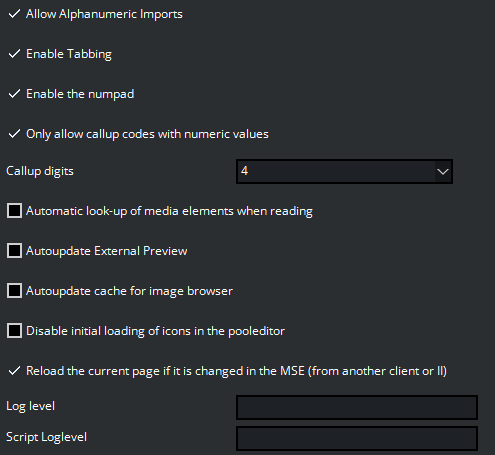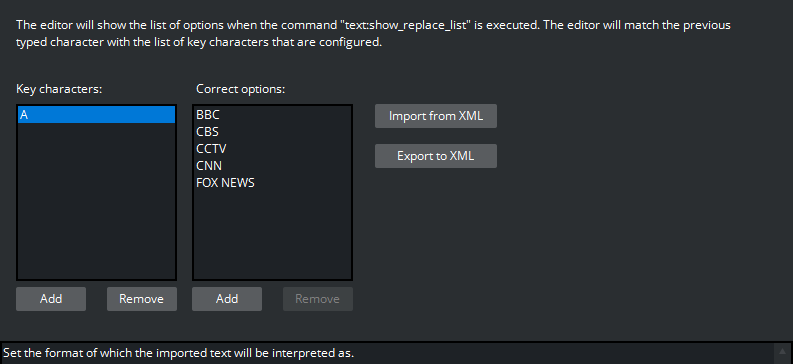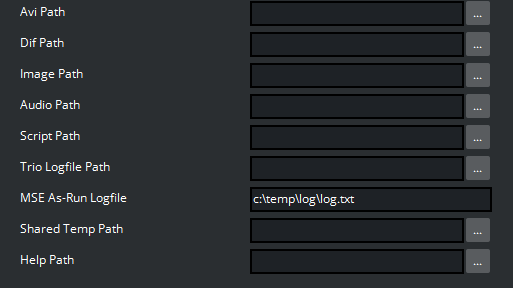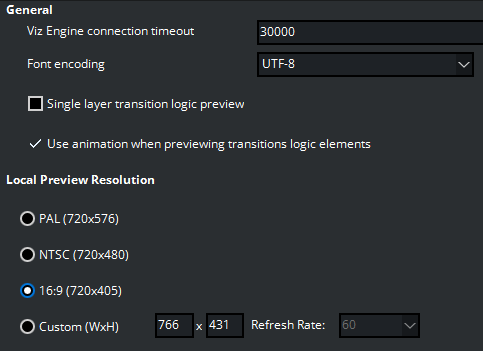
Viz Trio User Guide
Version 4.1 | Published September 25, 2023 ©
User Interface
The settings below are specific to the local Viz Trio client and do not affect any other Viz Trio clients using the same Media Sequencer.
This section covers the following topics:
General
To view the General configuration settings, click User Interface > General in the Trio Configuration.

-
Allow Alphanumeric Imports: Enable or disable import of scenes with alphanumeric names. When disabled, only scenes with numeric names will be allowed.
-
Enable Tabbing: When enabled, tabbing will iterate through the tab-fields of the element currently read.
-
Enable the numpad: When enabled, the numpad will type directly into the callup field. Holding down the CTRL button disables this function.
-
Only allow callup codes with numeric values: When checked, this setting will only allow callup codes with numeric values when a page is read or saved. When unchecked, this setting will allow all values.
-
Show Tabfield List: Select this option for the tab field list to be visible.
-
Callup digits: Sets the width of the two callup code edit fields on top of the Trio main window. Selecting 8, for example, will produce a wider code field while selecting 2 will produce a narrow code field. This setting has no impact on page name length.
-
Automatic look-up of media elements when reading: When enabled, this option will automatically display the video in the video search area when a video element is read. Note that this will slow down the reading of the element.
-
Autoupdate External Preview: When selected, the external preview channel will be automatically updated when a page is edited in the Viz Trio client. When not selected, the external preview channel will only update its preview when the page is saved.
-
Autoupdate cache for image browser: When enabled (default), the Viz Trio client will update the local image browser cache automatically and add any images that are new and update those which have changed. With very large image trees this update process might slow down the system response. To achieve better system response when the image tree is very large, disable this option.
-
Disable initial loading of icons in the pooleditor: When enabled, this setting will prevent the Viz pool browser from being loaded the first time a tab field, with for example Viz geometries or images, is selected. The icons are loaded when clicking in the browser or changing the path.
-
Reload the current page if it is changed on the MSE (from another client or II): If this setting is on, the currently read page is reloaded (read again) if it changes on the server.
-
Loglevel: Defines what kind of log messages that should be logged. Possible levels are: 0, 1, 2, 5, and 9. For more information, see Logging in Viz Trio.
-
Script Loglevel: Sets which log level to use when running scripts. It defaults to -1 , which is no logging. So if a script triggers a viz command, the script log level must be set to 9 to see the Viz Engine command in the log file.
-
Onair Password: Sets an on-air password. When set, all users will be prompted for the password when trying to take a Viz Trio client off or on-air.
-
Viz World Maps Editor: Defines the Viz World Map Editor (WME) to be launched when a map is added to the template. For more information on how to work with maps, please read the Viz World User Guide.
Note: The WME component requires a Viz World Client installation locally and a connection to one or more Viz World Servers or a Server Allocator.
-
Lite Edition (Inline): This embedded Map Editor has reduced functionality for map selection.
-
Classic Edition: Classic is the default editor. All the map features are exposed and the user has full control over the map selected.
-
Second Edition (SE): Second Edition is the next generation map editor.
-
-
Ignore Nameless tabfields during read: When enabled, this setting will discard error messages for tab fields with no name.
-
Create page icons from preview when saving Trio pages: Store a small thumbnail of the page in Media Sequencer. The thumbnail will reflect what is in the preview renderer. Do not use this mechanism as default for large shows, as Media Sequencer is not designed for extensive storage of binary data. To store specific page thumbnails, for instance if the default thumbnail is not good enough, send the command page:save_thumbnail in the Trio Commands page.
Keyboard Shortcuts and Macros
To view the Keyboard Shortcuts and Macros configuration settings, click User Interface > Keyboard Shortcuts and Macros in the Trio Configuration.
Keyboard Shortcuts and Macro Settings

In this section, keyboard shortcuts can be defined for various operations These shortcuts are global, which means that they are valid for all page folders. Local keyboard shortcuts can be specified per show by adding keyboard shortcuts and macros under the Show Properties.
-
Import and Export: The Import and Export function can be used to import and export shortcut settings to and from an XML-file for backup and reuse of typical configurations.
Note: The keyboard file has a *.kbd file extension.
-
Add Macro: allows an operator to write a Viz Trio macro command, and link it to a shortcut key.
-
Add Script: allows an operator to write a Visual Basic script, and link it to a shortcut key.
If a key combination is already in use, you are given the option of overriding it. This will leave the other command without an assigned keyboard shortcut.
Macros and scripts that are custom made can be removed using the Remove button. Select the custom made shortcut and click Remove.
Note: No warning is issued when performing this operation.
IMPORTANT! Avoid using SHIFT as part of a command as this will disable the possibility to use the assigned key when writing characters (e.g. in upper case).
Usage hints for the default keyboard bindings:
-
CTRL + N and CTRL + P are default bound to tabfield:next_property and tabfield:previous_property. They can be used to navigate between several tab-field properties under one tab-field, for example when working with text and kerning.
-
CTRL + TAB and CTRL + SHIFT + TAB can be used to move keyboard focus around inside the tab-field editors.
-
TAB and SHIFT + TAB can be used to move keyboard focus around as if the page editor is not active or no page is read.
Text Editor
To view the Text Editor configuration settings, click User Interface > Text Editor in the Trio Configuration.
The text editor contains general settings related to text formats and how to replace key characters.
General

-
Use CTRL + A Selection: When deselected, the normal key combination for selecting all text, CTRL + A will be disabled.
-
Support Unicode text-selection: Use this setting to enable or disable support for Unicode text-selection. This option is used if the default language for non-Unicode programs in Windows is set to a Unicode language. For example: If copying text from a text editor that by default does not support Unicode language into Viz Trio. The representation of text would not be correct.
-
Text import format: This option allows a character set to be specified for text imported and interpreted by Viz Trio. By default this is set to UTF-8.
Word Replace

Word replace allows key characters to have replace words defined. The list of replacement options becomes available in the text editor when running the text:show_replace_list command, see the User Interface section for how to define keyboard shortcuts.
The text editor matches the typed character with the list of key characters configured, and displays the corresponding replacement list. The word correction function is case sensitive, making it possible to define replacement options for both lower and upper case letters. The list of word correction options is local.
-
Key characters: Shows a list of defined replacement key characters.
-
Correct options: Shows a list of a key character’s corresponding replacement options.
-
Add: To add Correct options, a key character must be added first. To add Correct options, select the key character, and click the associated Add button.
-
Remove: Select a list item to remove, and click the associated Remove button.
-
Folder: Imports a predefined list exported to an XML file.
-
Save: Exports the predefined list to an XML file.
Example
<entry name="customcharacters"> <entry name="A"> <entry name="CBS"></entry> <entry name="CNN"></entry> <entry name="BBC"></entry> <entry name="ITN"></entry> <entry name="NBC"></entry> <entry name="NRK"></entry> <entry name="YLE"></entry> <entry name="SVT"></entry> <entry name="CCTV"></entry> <entry name="TV2"></entry> <entry name="ZDF"></entry> <entry name="RTL"></entry> </entry></entry>Page List/Playlist
To view the Page List/Playlist configuration settings, click User Interface > Page List/Playlist in the Trio Configuration.
General Settings
-
Hide empty locked groups: This setting will prevent locked groups with no pages from being displayed in the page list.
-
Select next element in playlist after read: When enabled, the next element in the playlist will automatically be selected after a read operation.
-
Remove MOS-playlist from show: Removes newsroom playlists that are monitored using the MOS protocol when the show is closed. Setting this to Yes will also affect other clients connected to the same Media Sequencer. The available options are: Yes, No and Ask.
-
Automatically reactivate playlists when profile changes: If enabled, active playlists are reactivated when the current profile is changed.
-
Automatically activate show when opening: If selected, automatically activate the show when opened. Please be aware that this option, if used, could put a high load on the Media Sequencer.
-
Use Preview Server to load thumbnails: If selected, use Preview Server to load thumbnails.
Cursor Settings
-
Autopreview (single-click read): When enabled, a page will be read as soon as it is selected.
-
Autocenter cursor: With this function enabled, the cursor will have a static position when the page list is longer than the Page List window. In these situations the window is provided with a scrollbar on the right side. With Autocenter Cursor enabled, as long as some pages are hidden in the direction the list is browsed, the cursor will remain static and the list items will move instead. When the last item is revealed, the cursor will start to move again.
Paths
To view the Paths configuration settings, open File > Configuration > User Interface > Paths in the Trio Configuration.
This section describes the directories settings for several functions. All settings are local to the specific Viz Trio client.
Paths Configuration Settings

-
Avi Path: Sets the default location when browsing for AVI files.
-
Dif Path: Sets the default location when browsing for DIF files.
-
Image Path: Sets the default location when browsing for Image files.
-
Audio Path: Sets the default location when browsing for Audio files.
-
Script Path: Sets the default directory to file-based scripts that may be assigned to a Viz Trio show and/or template.
-
Trio Logfile Path: Sets the path to the directory where the Viz Trio client should store log files. For more information, see To change the Viz Trio log file path.
-
MSE As-Run Logfile: Sets the path to the Media Sequencer as-run log file. This log file offers a Media Sequencer logging mechanism for all elements that have been taken on air. The as-run log file is an additional debugging tool which a Viz Trio administrator may want to enable to verify that the communication between Media Sequencer and the playout engine is working properly. The file name may be given with either relative or absolute path.
Note: This is a global setting, affecting all clients connecting to the specified Media Sequencer. Also note that the as-run log file ends up on the Media Sequencer host, not on the local Viz Trio machine. Read more about the as-run log file in the Media Sequencer documentation at http://<mse-host>:8580/mse_manual.html#as-run-log.
-
Shared Temp Folder: Used for temporary files when importing or exporting Viz Trio shows on an external Viz Engine. This must be a network share that is both accessible for the client and the external Viz Engine.
-
Help Path: Sets the path for the main help file. Help will be opened when pressing F1 or when clicking View Help under Help in the main menu.
Local Preview
To view the Local Preview configuration settings, click User Interface > Local Preview in the Trio Configuration.
Local Preview Configuration Settings

-
Viz Engine connection timeout: Sets the number of milliseconds until the local Viz Engine renderer times out. Changes to this setting requires a restart of Viz Trio.
-
Font encoding: Sets the font encoding format of text sent to the local preview. This setting overrides the local Viz preview and requires a restart of Viz Trio to take effect.
Note: This does not have an effect on remote Viz Engines; hence, the font options for Viz must be set accordingly. Also note that the Viz Trio interface only supports the font encoding set for the operating system under the Regional and Language Options settings (i.e. support for complex script, right-to-left and East Asian languages).
-
Single layer transition logic preview: Enable previewing of single-layer pages in the background scene. If this setting is disabled, only Combo pages will be previewed in the background scene.
-
Use animation when previewing transitions logic elements: If this setting is off, the transition logic animation will be skipped in the local preview. This requires that each foreground scene defines a "pilot1" tag on a director. By default, this setting is on. In the Local Preview Resolution section the aspect ratio for the local preview window can be set, and the systems refresh rate defined (normally 50 for PAL and 60 for NTSC).
User Restrictions
To view the User Restrictions configuration settings, click User Interface > User Restrictions in the Trio Configuration.
User Restriction Settings

The User Restrictions section lets an administrator deny the operator from performing certain actions in Viz Trio.
-
Page:
-
Delete Templates: When checked, prevents the operator from deleting templates from the show. Command: show:delete_templates.
-
Direct Takeout Pages: When checked, prevents the operator from issuing a direct take out command on pages in a show. This also disables the context menu option for the show. Command: page:direct_takeout.
-
Direct Takeout Pages from a Playlist: When checked, prevents the operator from issuing a direct take out command on pages in a playlist. Command: playlist:direct_take_out_selected.
-
Rename pages: When checked, it is not possible to rename saved pages in the page list.
-
Save values to linked databases: When checked (default), prevents the operator from saving values back to the database.
-
Takeout Pages: When checked, prevents the operator from using the Take Out command. This also disables the Take Out button in the Page editor. Command: page:takeout.
-
-
Post Rendering:
-
Enter new hostnames in post render view: When checked, prevents the operator from adding new hostnames to the Render Videoclip editor.
-
-
Scripts:
-
Edit scripts: When checked, prevents the operator from editing the script using the Edit Script button in the Page editor. Command: gui:show_scripteditor.
-
-
Scroll Editor:
-
Create new scroll templates: When checked, prevents the operator from creating new scroll templates. Command: gui_show_scroll_template_creator.
-
-
Shows:
-
Access Show Properties: When checked, prevents the operator from accessing the Show Properties. Command: gui:show_settings.
-
Browse external playlists: When checked, disables the Playlists tab under Toolbar, and consequently preventing the operator from browsing for playlists on Media Sequencer.
-
Browse viz directories when changing shows: When checked, disables the Viz Directories tab under Toolbar, and consequently preventing the operator from browsing the Viz directory to set a show path.
-
Create or rename shows: When checked, prevents the operator from creating new Shows or renaming existing shows.
-
Delete all pages in a show: When checked, prevents the operator from selecting and deleting all pages in the show in one operation. Normal page by page and page group deletion is still possible.
-
Open the window for importing templates into a show: When checked, prevents the operator from importing new scenes from Graphic Hub (Viz 3.x) or the data root (Viz 2.x).
-
-
Trio:
-
Call Viz Trio Commands: When checked, prevents the operator from manually calling Trio Commands. This does not prevent scripts from doing the same. Command: gui:show_triocommands. See Working with Macro Commands.
-
Cleanup External Renderers: When checked, prevents the operator from issuing a cleanup renderer command. Command: trio_cleanup_renderers.
-
Switch to Viz Artist: When checked, prevents the operator from switching to Viz Artist mode. Command: gui:artist_mode.
-